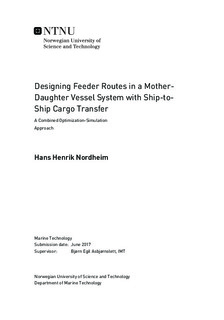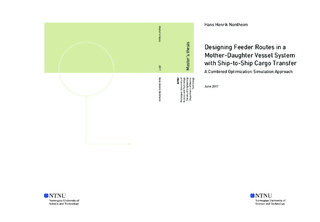| dc.description.abstract | This thesis aims to develop decision support models for designing daughter vessel feeder routes for the mother-daughter vessel system Short Sea Pioneer. Short Sea Pioneer is a next generation short sea shipping system that utilizes daughter vessels to feed containers between small and remote ports and the mother vessels. Although Short Sea Pioneer presents potential benefits such as shorter roundtrip times and reduced time spent in port for the mother vessels, the system also poses higher complexity compared to conventional short sea shipping systems by introducing more elements that need to be precisely coordinated. Cargo transfer between mother and daughter vessels finds place at sea which implies that the schedules for the mother vessels and daughter vessels must be coordinated.
An optimization model is constructed to generate daughter vessel feeder routes based on required number of visits for the involved ports for a given planning horizon and the scheduled arrival times of mother vessels in the area. To assess and increase the robustness of the generated routes, and to ensure that the system can cope with small variations in the operating environment, a discrete event simulation model is developed. The simulation model is used to evaluate the generated routes when the system is subject to uncertainties and a dynamic nature. A script to estimate the operability of the ship-to-ship cargo transfer operation based on operational criterion and the duration of the operation is also made. The constructed models are limited to the operation of one daughter vessel.
To demonstrate potential application areas of the models, and to verify that they work as intended, the models are applied on a constructed feeder case for the Trondheim Fjord. The simulation model is verified by first running it with deterministic input data. The effect of 24/7 port service versus restricted port opening hours is evaluated. The analysis shows that results from the optimization model are not much affected by introducing restricted port opening hours. However, when the routes are evaluated in the simulation model, it is evident that the robustness of the routes decrease for restricted port opening hours. By designing the routes for transportation demands above the average level, new routes are established. These routes perform better in the stochastic scenario. Combined use of the optimization and simulation model highlights the importance of considering uncertainties when designing the system.
The constructed models are based on a range of assumptions about the operating context of the vessel that should be kept in mind if one wishes to utilize the models. Regarding further work it is recommended to include stakeholders in the project and system experts to review and revise the assumptions to increase the credibility of the models. Stakeholders should also be included in the formulation of the objective functions to make sure that their requirements are better met in the solutions. | |

